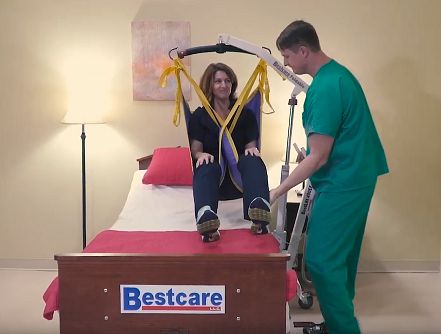 Written by Mike Price, OT
Written by Mike Price, OT
Also known as hospital lifts, handicap lifts, Hoyer lifts, and mechanical lifts, patient lifts are used wherever people need assistance with mobility and transfer. Hospitals and long-term care facilities use them, as do home health care aides and family caregivers. They help to prevent injuries to both patients and caregivers that are often associated with manual lifting and transfers.
Specially designed to safely move people from one surface to another, patient lifts are available in a wide array of styles to provide comfortable and supported patient transfers. Because of this wide selection, choosing the right patient lift for your needs might be a challenge, but we’ve reached out to some of the most experienced experts in the industry to get their most important tips that people should keep in mind when choosing a patient lift.

Choosing the right lift can be difficult, but it doesn’t have to be. There are tons of resources out there on the subject, and your care team will be happy to help you make the right decision, but sometimes you just want another perspective. Speaking with an expert is the best resource, but most people don’t have access to industry experts. That’s why we gathered some of the best to get their tips just for you!
Curtis Philyaw, ATP and CPST, is R82’s Product Manager. As a worldwide manufacturer of assistive furniture, devices, and aids for children and young people living with disabilities, R82 is well-known in the healthcare industry as a gold standard for durable medical equipment. In addition to their own reputation for excellence, R82 is a part of the larger Etac company, who has been providing mobility solutions for over 40 years. This includes a comprehensive selection of patient transfer and lift equipment to make everyday life easier.
Working closely with industrial designers and rehab professionals, Etac creates unique, ergonomic, and award-winning patient lifting equipment to ensure safety and comfort for both patients and caregivers.
When asked what he considered to be the most important aspects of choosing the best patient lift, Philyaw explained that it's essential to take the user and the environment into consideration before anything else. He said,
BranEric Holmes is Medline Industries’ Post Acute Sales Representative. As America’s largest private provider of medical supplies and solutions, Medline has been a family-led company for four generations. With a professional team comprised of researchers, clinicians, and engineers, Medline is firmly committed to improving patient care through its superior quality medical products, for both the healthcare professional and the patient.
Holmes directed his advice for hospitals and other professional medical facilities, although much of this information is still relevant for the home caregiver. He said,
Erin Schoenherr is the Clinical Trainer at Handicare. Handicare was founded in 1986 by three men who met in a rehabilitation center, and felt that there was a need to find a better way of caring for patients. Their passion for innovation led them to found the company and try to create exceptional tools. Making a positive difference in the lives of millions of folks around the globe, Handicare is dedicated to providing peace of mind to family caregivers to keep their loved ones safe and mobile, and enable healthcare professionals to better care for their patients with the right tools for each job.
Schoenherr supplied us with valuable information regarding the various kinds of lifting equipment, and exact patient parameters to consider for when each kind of equipment is appropriate. She explained,
“Gait belt to Return (Minimal Assistive Lift): Patient using a Return must be able to support own weight while standing, stand up and maintain balance (or with the support of Return Belt), has grip strength, and can understand instructions clearly. A patient only using a gait belt must be able to support their own weight, can walk short distances, understand instructions clearly, & maintain balance while standing or walking.
Betty Bogue, RN & BSN, is Invacare’s Resident Safe Patient Handling Expert. Since 1885, Invacare has been a major innovator in the medical and disability industries. As a global leader in home-care and long-term care medical products, they offer a wide array of patient lifting and transfer equipment for both residential and institutional utilization. They focus on promoting recovery and active lifestyles, and delivering the best value in medical products.
Bogue told us,
She provided us with this helpful guide to assist our readers in better determining the appropriate device, type, and size of patient lift to acquire for every individual.
Nancy Hollier is the National Education Program Director for Tollos. With their highly appropriate tagline, ‘Lightening the Load of Care’, Tollos knows a thing or two about safe patient handling. They have built a broad portfolio of quality mobility equipment through the years, with their popular products utilized by clinicians and patients throughout North America.
Their specialties include ceiling lifts, mobile lifts, lateral transfer, and other innovative patient handling devices, making them one of the foremost experts on patient lifting and transfer devices.
Hollier was happy to share her expertise for choosing a patient lift, offering several suggestions for the most important considerations:
Patient lifts are an integral part of proper patient handling, and are one of the best ways to transfer patients who cannot assist themselves from one surface to another. Medical innovations and a range of companies who care deeply about patient safety and comfort have led to a wide variety of patient lifts on the market, offering solutions for every patient need.
Unfortunately, this variety of lifts means that it may sometimes be challenging for caregivers to know and understand which lift is the best for their patients and loved ones. That’s why we reached out to industry experts for their best tips on how to choose a patient lift.
While every expert offered their own unique perspective, almost all of them mentioned that the most important thing to consider is the individual needs of your patient, your environment, and yourself - the caregiver. Taking all those things into account will help you land at the perfect lift much more easily.
For more helpful tips from medical experts, check out the rest of our articles at Caregiver University, and be sure to visit Rehabmart.com for all your durable medical equipment needs.

Co-Founder of Rehabmart and an Occupational Therapist since 1993. Mike has spent his professional career working in multiple areas of Occupational Therapy, including pediatrics, geriatrics, hand therapy, ergonomics and inpatient / outpatient rehabilitation. Mike enjoys writing articles that help people solve complex therapeutic problems and make better product choices.